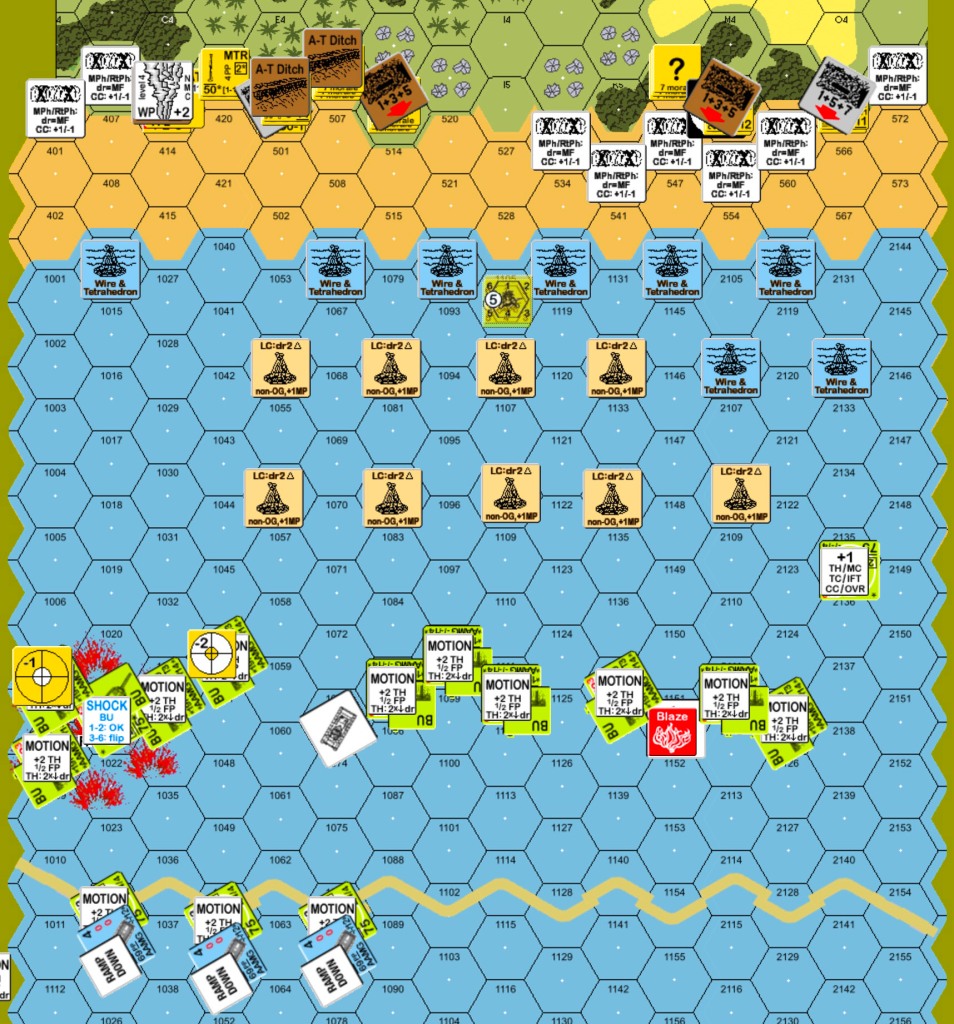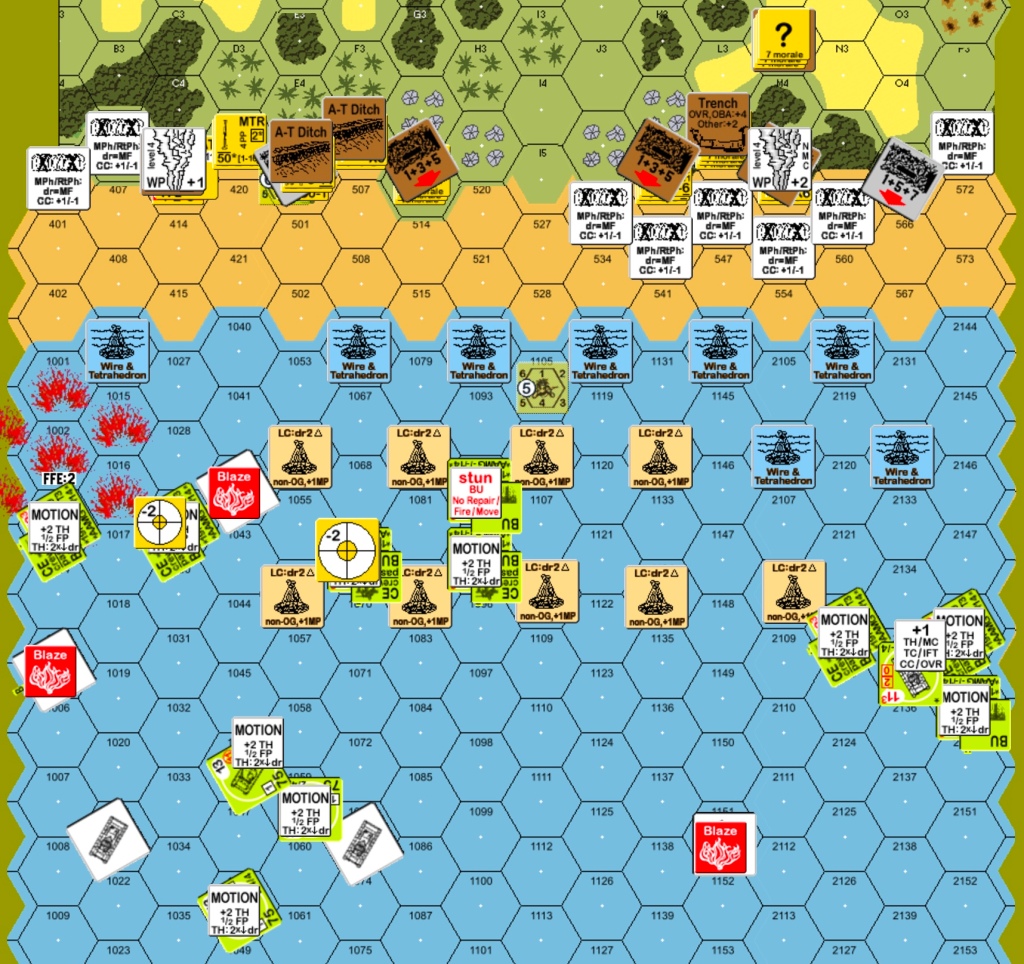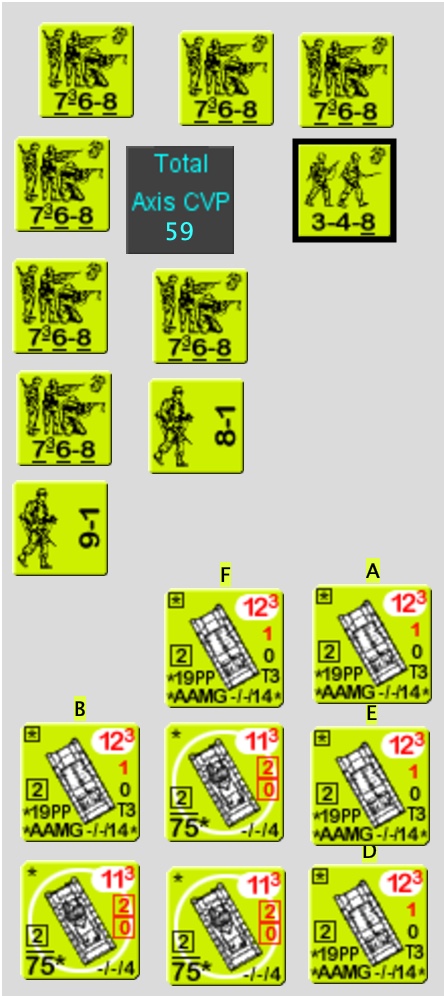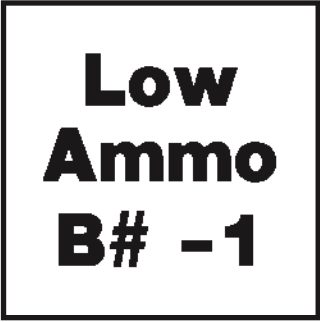This scenario portrays a seaborne assault by marines against the Japanese island of Peleliu in September of 1944. Being a World War 2 history buff, I have read “With The Old Breed” by Eugene Sledge. If memory serves me well, a significant part of the the book takes place on Peleliu. This book was part of the material used in the making of HBO’s series “The Pacific”, so Peleliu was in there as well. That was part of the attraction of this scenario for me. During WW2, the island was strategic for its airfield. The other attraction was the LVT(A)4 amphibious tanks. There are not a lot of scenarios that use these AFV.
Pete Mudge designed this scenario. It appeared in issue three of Critical Hit magazine in the year 1995. If you are wondering why I am playing such old scenarios, the number one reason is the limited number of seaborne assault scenarios. The victory conditions require the Americans to exit 24 VP off the east edge of the map AND have no Good Order Japanese MMC on or adjacent to the beach AND avoid a CVP cap of 56 CVP. They have 9.5 turns to accomplish this. That sounded like a tall order to me. I can’t remember another seaborne assault that has a CVP cap. I thought it was odd, considering that seaborne assaults tend to have a lot of casualties.
The scenario also features a submerged reef (G13.43) and napalm (G17.4). The submerged reef prevents the three landing craft (carrying tanks) from reaching the beach, but they can beach on the reef. All the ocean hexes from the reef to the beach are shallow ocean hexes. A scenario special rule changes all bamboo to crags and makes the crags to rally and ambush terrain; it also allows the pillboxes to be in crag.
One part of SSR 1 is unclear to me. It states “The Americans are conducting a seaborne assault [EXC: No LVT with a PP capability may attempt to enter a Hinterland hex]. Does that mean no LVT(A)2 can enter a Hinterland hex ever or does it mean that no empty or partly empty LVT(A)2 can enter a Hinterland hex? I lean towards the former. The question became moot in our playing.
This scenario epitomizes the marine assaults that took place during the island hopping campaign. Seriously dug-in Japanese with fortifications and beach obstacles await the marines. The Japanese have a good amount of fortifications, but do not have a lot of infantry; however, the map is only one board wide and they have a lot of weapons. The are three 448 squads with five 228 crews. They operate a HMG, a MMG, three LMG, a 50mm mortar, a 20L ATR and a 47L AT gun. They have a DC with which to get adventurous. They are also supported by an OBA module of 70mm directed by an offboard observer (unusually, the observer hex is designated). The fortifications are two AT ditches, 40 AP mine factors (that cannot be switched to AT), three wood pillboxes, two stone pillboxes, three trenches, eight wires, ten tetrahedrons and twelve wired-tetrahedrons. Being Japanese gives them tunnels with the pillboxes. The Japanese receive reinforcements of a few squads in their turn six.
The Americans attack with fifteen 768 squads carried by ten LVT(A)2 amphibious tractors. They have five leaders, including a 10-2, and multiple HMG, MMG, FT, DC and BAZ. The LVT(A)2 have AAMG of 14 firepower (6MA&4&4), but unloading costs 50% of its MP allowance, rather than the usual 25%, because of its high sides and no ramp. This group enters the map on turn one. The platoon of four LVT(A)4 amphibious tractor tanks starts on board, on the submerged reef, in motion. There is also American air support available on turn one; two FB, one with bombs the other with Napalm. On turn two, three LCM(3) enter, each carrying one M4A1 Sherman.
The LVT(A)4 are nice weapons to support the landing; they have 75mm MA that can fire HE, canister, white phosphorus and heat ammunition. It would have been better for the Americans, however, if the platoon could start the scenario not in motion. The Shermans can fire HE, AP, WP and smoke.
Here is the Japanese setup, with everything showing (but the tetrahedrons on the reef are relocated before play begins).

The scenario gives the Americans the possibility to remove six tetrahedrons using the mechanics of a Set DC (G14.56), which is similar to removing wire. Spoiler alert: this was the best luck I had during the game. In six attempts, I was successful five times; I created a large opening on the north side and a small one on the south side. This is the situation after the removal of five tetrahedrons.

The amphibious tanks start 10 or 11 hexes from the beach. For a reason I cannot remember, I decided to move them a little closer. They unbutton, to be able to start laying acquisition marker in the AFPh. The LVT(A)2 can move only three hexes during their first turn, because they are swimming in deep ocean until they enter a reef hex. In the DFPh, the Japanese 37L AT gun comes on board and starts shooting at an amphibious tank, but only double acquires it. Vehicles are considered to be a wading while in a shallow ocean hex; they receive a +2 TH DRM (G13.442). We mistakenly played that they are also hull down because of D16.3. Since the shallow ocean is not a water obstacle to vehicles, D16.3 does not apply. I learned that when I wrote this AAR, because I have time to verify things that we did. The Japanese HMG with a 9-1 directing shoots at the exposed crews. This makes me wish I had kept the amphibious tanks outside of the HMG normal range of 14. One crew is pinned and two are stunned. At least the Japanese OBA started with a red card.
In Japanese turn one, the AT gun has a nice run of rate. On its third shot against its acquired target, it achieves the necessary turret hit, but the TK is ineffective. It gets one more shot against the hull and loses rate. A 50mm mortar has the same target acquired and achieves a turret hit, then rolls low enough to shock that amphibious tank (which had drm of -1 for OT, and -1 for all armour ≤ 4). The mortar switches to another amphibious tank. It gets a hull hit, then a turret hit for no effect, then another turret hit with a snake-eyes effects roll to burn that tank (5 CVP). Then the mortar malfunctioned. The American bombers come one. First one, with bombs targets the AT gun in a point attack. Two MG attacks obtain MC against the crew; they pass both. The bomb misses. The second bomber also targets the AT gun. The MG attacks manage to stripe the crew, but the napalm misses. The one amphibious tractor left that can fire weapons adjusts its acquisition onto the AT gun.

American turn two starts with the shocked amphibious tank failing to recover; it is now UK. The one amphibious tank that can fire puts WP on the AT gun; the crew passes the MC. The tank breaks its AAMG firing at other Japanese infantry. The LCM(3) have enough MP to enter, beach on the reef, and unload the Shermans. By SSR, the Shermans are waterproofed. This means they can’t be swamped as they wade in and they will pay 3 MP per hex (it would be 4 MP if they were not waterproofed). The Japanese OBA targets the amphibious tank. The OBA hits it and also an LVT(A)2, but both survive. In Japanese turn two, the UK amphibious tank dies, but the AAMG repairs. I often say during a game “I’d like to swap those die/dice rolls” (+5 CVP, 10 total). The Japanese OBA corrects and brings two more LVT(A)2 into the FFE. It shocks the amphibious tank. The DR are too high to hurt the three LVT(A)2. The American FB have their second and final try at doing harm with their MG. Since the AT gun is in WP, the first plane targets the HMG team that had left its pillbox to increase its field of fire. The second attack causes a NMC. The Japanese leader rolls boxcars to die, but the crew is unaffected. The second plane misses the sighting task check against the same target.

American turn three also starts with a shocked amphibious tank going to UK status. At least the stunned amphibious tank is back in action. It puts WP on the ATR position. As the amphibious tractors advance, the Japanese break a MMG and a LMG shooting at them as ordnance. The OBA leaves the shocked tank to go after the LVT(A)2. The FFE catches two of them; one is missed but the other receives a CH, so no crew survival roll for the passengers: one squad with SW and one half-squad (+8 CVP, 18 total). The remaining LVT(A)2 have their crews go CE (not their passengers, which one can do with LVT [G14.31]) to use their AAMG. Japanese turn three starts with bad repair rolls, but the UK tank also gets a bad roll and dies (+5 CVP, 23 total). The AT gun shoots out of WP at an acquired LVT; on its second shot, it rolls a CH. The TK is low enough to burn the LVT, so again no passengers can survive. This one is loaded exactly the same as the last one that died, so the Japanese gain another 8 CVP (31 total). The ATR breaks, but the HMG stuns an LVT(A)2.

In American four, the lone surviving amphibious tank manages to land a WP round on the HMG team. On the south (right) side, I bring three tractors closer to the beach. At least one of them could have made it onto the beach, but I can’t remember why I chose not to move it there. In the middle of the map, the tractor that was stunned last turn moves onto the beach where it is taken under fire by a LMG. The LMG stuns it again, but does not force Recall (G14.33). A second tractor moves onto the middle beach, takes fire, but is unaffected. A third tractor moves onto the north half of the beach. The AT gun, now free of WP, hits and burns it. This one has a 9-1 leader in addition to the 1.5 squads (+10 CVP, 41 total). The remaining forces move closer, but no one else touches the beach. The Shermans stop to be able to give supporting fire in the near future. The OBA adjusts to bring two tractors into its blast area. The first DR is snake-eyes; a CH. Another burning tractor that had a -1 leader with 1.5 squads (+10 CVP, 51 total). The AT gun has kept rate, but does not kill another tractor. One Sherman obtains an improbable hit on the AT gun, but the crew passes the MC. In the next Japanese PFPh, the OBA draws its second red. The AT gun fires at its acquired motion tractor on the beach, hits it and rolls low enough on the TK to burn it. No leader on this one so +8 CVP for a total of 59, exceeding the cap of 56. Game over.
I still had left the following assets: three Sherman tanks, one amphibious tank, 7.5 squad equivalents in five tractors, three leaders including a 10-2, a BAZ, a FT, two HMG, a MMG and a DC. Considering the minimal damage done to the Japanese and their fortifications, I doubt the remaining assets could have accomplished the mission had there been no CVP cap.

So besides asking Magnus to roll higher, what could I have done differently as the American player? For sure the amphibious tanks are better off to stay on or near the reef to do their support. The tractors might need to wait a bit until the Shermans unload to offer more support, but do they have the time? The LCM(3) have 4 MP. They can beach on the reef on their third MP. In analyzing this, I found out that we erred by letting the Shermans unload on the fourth MP because the Shermans need to also to have MP to cover the COT of the hex that the tanks enter. This means that the earliest the Shermans can put smoke or WP on the beach is turn four. The tractors would approach the beach at less than maximum speed to arrive in the smoke of the Shermans and amphibious tanks. It is still possible to loose several tractors to the AT gun and OBA during their run in. The survivors would have six turns to eliminate all the Japanese MMC and secure the area to prevent the Japanese reinforcements from getting to close to the beach. The Americans also need to exit 24 VP; the three Shermans and 1.5 squads could accomplish that. This is still a tall order. Let’s not forget about the 32 factors of minefields. The balance for the Americans is one extra turn. That might help if there was not a CVP cap. I believe that the Americans cannot win this scenario with average luck on both sides.
Marine casualties:


A good read and a nice analysis.
LikeLike